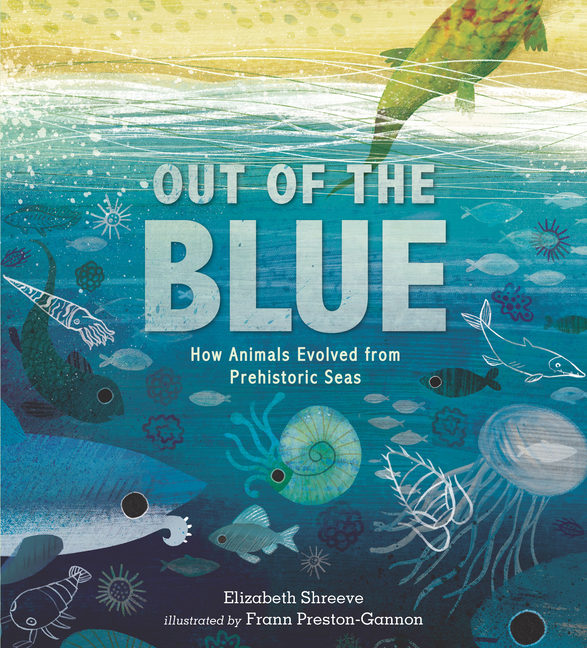Book Descriptions
for Out of the Blue by Elizabeth Shreeve and Frann Preston-Gannon
From Cooperative Children's Book Center (CCBC)
“Life began in the vast empty sea, when Earth was young. First came single-celled microbes … ” Those microbes thrived for billions of years on an unrecognizable earth, slowly changing until, “Gulp! One microbe swallowed another. Strange, squishy creatures evolved.” It’s no easy task to cover the evolution of life on earth across millennia in a picture book, but an informative conversational text paired with smart design elements make this effort a success. The text is set against inviting digitally rendered illustrations showing life on earth and some of the many creatures thriving during different periods. A key design element appears across the bottom each page spread: a colored band identifying the current period being described along with how long ago it was (e.g., Silurian Period, 444 to 419 million years ago). Moving forward to the present Cenozoic Era, which began 66 million years ago heralding the Age of Mammals, the narrative and art give a dynamic sense of life on earth in each period, as well as evolutionary and other change over time. Hippos, not humans, are the final example of evolutionary change here, but human figures are used occasionally throughout as a measurement of scale to show the size of some prehistoric creatures. (Ages 7-10)
CCBC Choices 2022. © Cooperative Children's Book Center, Univ. of Wisconsin - Madison, 2022. Used with permission.
From the Publisher
Graceful, succinct prose and engaging illustrations trace the evolution of life on Earth out of the blue and back again.
Clear and inviting nonfiction prose, vetted by scientists—together with lively illustrations and a time line—narrate how life on Earth emerged “out of the blue.” It began in the vast, empty sea when Earth was young. Single-celled microbes too small to see held the promise of all life-forms to come. Those microbes survived billions of years in restless seas until they began to change, to convert sunlight into energy, to produce oxygen until one day—Gulp!—one cell swallowed another, and the race was on. Learn how and why creatures began to emerge from the deep—from the Cambrian Explosion to crustaceans, mollusks to fishes, giant reptiles to the rise of mammals—and how they compare to the animals we know today, in a lively and accessible outing into the prehistoric past that boils a complex subject down to its lyrical essence.
Clear and inviting nonfiction prose, vetted by scientists—together with lively illustrations and a time line—narrate how life on Earth emerged “out of the blue.” It began in the vast, empty sea when Earth was young. Single-celled microbes too small to see held the promise of all life-forms to come. Those microbes survived billions of years in restless seas until they began to change, to convert sunlight into energy, to produce oxygen until one day—Gulp!—one cell swallowed another, and the race was on. Learn how and why creatures began to emerge from the deep—from the Cambrian Explosion to crustaceans, mollusks to fishes, giant reptiles to the rise of mammals—and how they compare to the animals we know today, in a lively and accessible outing into the prehistoric past that boils a complex subject down to its lyrical essence.
Publisher description retrieved from Google Books.


